![]()
In this chapter, you’ll learn:
Verbal and nonverbal methods of communication
The phases of a therapeutic relationship
How to incorporate therapeutic use of self
How to identify and handle communication barriers
The importance of communication in documenting patient care.
What is communication? Communication is a way to fulfill a person’s basic need to relate to others. Communication is dynamic and ongoing and is a way to interact and develop relationships. It’s also a way to effect change.
Nurses encounter many people during the course of their education and nursing career. They communicate with educators, patients, family members, and other members of the health care team. Learning to communicate effectively is a skill that sometimes takes time and effort.
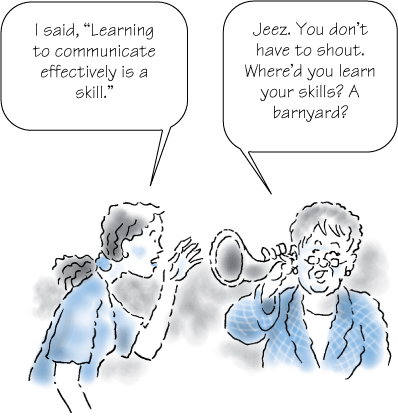
Verbal communication is the transmission of messages through spoken or written language. For effective verbal communication, six criteria must be met:
 Simplicity
Simplicity Clarity
Clarity Timing and relevance
Timing and relevance Adaptability
Adaptability Credibility
Credibility Hostile-free patterns of communication.
Hostile-free patterns of communication.In verbal communication, you must state complex information in commonly understood terms. This is especially important when communicating with patients. For instance, when explaining a procedure to the patient, you must be careful to use the most appropriate terminology that the patient will understand. Use short sentences that express the idea completely. Long explanations are sometimes difficult for people to understand because the context of the explanation gets lost.
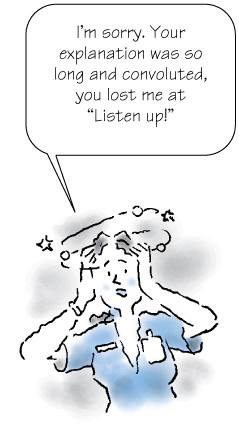
Avoid using medical terminology. For instance, when asking a patient whether they needs to use the bathroom facilities, the patient won’t understand, “Do you have to void?” They will better understand what you mean if you ask them if they have to urinate or go to the bathroom.
Verbal communication must be clear. You should state exactly what you mean. Communicate in a respectful manner to maintain a hostile-free environment. Don’t make the listener guess what you mean or make assumptions.
For instance, if you’re explaining a medication regimen to a patient who has never taken medicine before, don’t tell them they must take the medication four times per day. You must be clear and tell them exactly how many hours should elapse before taking the medication.
Make sure that the message is communicated at a time when the receiver is ready to receive it. If your patient is in pain, don’t try to explain a procedure or do patient teaching. They will be more receptive when the pain subsides.
Ensure that the message is communicated in an appropriate format. If your patient has trouble visualizing what you’re saying, try using written materials or diagrams to complement your verbal explanation to help them to understand better.
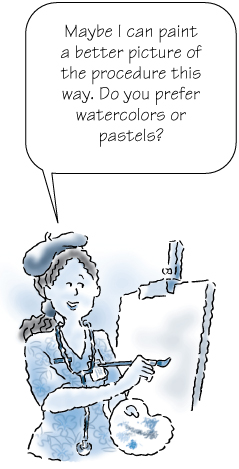
Communication that’s effective is adaptable and states the message that reflects the situation. For instance, as you prepare your teaching plan, you may need to adapt the way you communicate if the patient is hearing or visually impaired or speaks another language.
Verbal communication also shows appropriateness to the receiver. If the patient is a young child or an infant, it may be necessary to communicate with the parents or guardian instead of the child.
In order for communication to be credible, it must be stated in a trustworthy and believable manner.

It must also be accurate, consistent, and honest. Before you communicate with someone, make sure that you know the content area. Communication commonly spurs continued conversation, so be prepared and well versed in your subject in order to be able to answer any question that arises. If you’re asked to explain information that’s beyond your scope of practice or your ability, you must be honest with the patient and tell them that you can’t answer their question. Explain, however, that you’ll convey their concerns to someone who’ll be able to answer them.
Verbal communication strategies range from alternating between open-ended and closed questions to employing such techniques as silence, facilitation, confirmation, reflection, clarification, summary, and conclusion.
Asking open-ended questions such as “How did you fall?” lets the patient respond more freely. The response may provide answers to many other questions. For instance, from the patient’s answer, you might learn that they have fallen previously, that they were unsteady on their feet before they fell, and that they fell just before eating dinner. Armed with this information, you might deduce that the patient had a syncopal episode caused by hypoglycemia.
You may also choose to ask closed questions. Although these questions are unlikely to provide extra information, they may encourage the patient to give clear, concise feedback.
Two ways to askQuestions can be characterized as open-ended or closed.
| Open-ended questions Open-ended questions require the patient to express feelings, opinions, and ideas. They also help you gather more information than can otherwise be gathered with closed questions. Open-ended questions encourage a good nurse–patient relationship because they show that you’re interested in what the patient has to say. Examples of such questions include:
|
| Closed questions Closed questions elicit “yes” or “no” answers or one- or two-word responses. They limit the development of the nurse–patient relationship. Although closed questions can help you “zoom in” on specific points, they don’t provide the patient with an opportunity to elaborate. Examples of closed questions include:
|
Another technique is to allow moments of silence during the interview. In addition to encouraging the patient to continue talking, this technique also gives you a chance to assess his ability to organize thoughts. You may find this technique difficult (as most people are uncomfortable with silence), but the more often you use it, the more comfortable you’ll become.

Using such phrases as “please continue,” “go on,” and even “uh-huh” encourages the patient to continue with their story. Known as facilitation, this feedback shows them that you’re interested in what they are saying.
Employing the technique of confirmation helps ensure that you and the patient are on the same track. You might say, “If I understand you correctly, you said,” and then repeat the information the patient gave. Doing so helps to clear up misconceptions that you or the patient might have.
Try using reflection—repeating something the patient has just said—to help you obtain more specific information. For example, a patient with a stomachache might say, “I know I have an ulcer.” If so, you can repeat, “You know you have an ulcer?” Then the patient might say, “Yes. I had one before, and the pain is the same.”

When information is vague or confusing, use the technique of clarification. For example, if your patient says, “I can’t stand this,” your response might be, “What can’t you stand?” or “What do you mean by ‘I can’t stand this’?” Doing so gives the patient an opportunity to explain their statement.
Get in the habit of restating the information the patient gave you. Known as summarization, this technique ensures that the data you’ve collected are accurate and complete. Summarization also signals that the interview is about to end.
Signal the patient when you’re ready to conclude the interview. This signal gives them the opportunity to gather thoughts and make any pertinent final statements. You can do this by saying, “I think I have all the information I need now. Is there anything you would like to add?”
Nonverbal communication transmits messages without using words. It’s commonly referred to as body language. Nonverbal communication includes facial expressions, posture, gait, hand gestures, tone of voice, positioning and space, touch, appearance, and level of alertness. Nonverbal communication can convey feelings of sadness, joy, and anxiety. It reflects self-concept, current mood, and health.
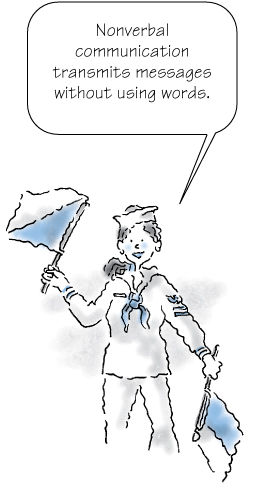
Nonverbal communication not only aids interpretation of verbal communication but also requires acute observation by the receiver for accurate interpretation of the message. For instance, your patient may state that the pain has subsided, but you notice that they are guarded and clenching the side rails on the bed. Verbal communication tells you one thing, but nonverbal actions reveal something else.
To make the most of nonverbal communication, do the following:
Listen attentively and make eye contact frequently.
Use reassuring gestures, such as nodding your head, to encourage the patient to keep talking.
Watch for nonverbal clues that indicate the patient is uncomfortable or unsure about how to answer a question. For example, they might lower their voice or glance around uneasily.
Be aware of your own nonverbal behaviors that might cause the patient to stop talking or become defensive. For example, if you cross your arms, you might appear closed off from them. If you stand while they are sitting, you might appear superior. If you glance at your watch, you might appear to be bored or rushed, which could keep the patient from answering questions completely.
Observe the patient closely to see whether he understands each question. If they do not appear to understand, repeat the question using different words or familiar examples. For instance, instead of asking, “Did you have respiratory difficulty after exercising?” ask, “Did you have to sit down after walking around the block?”
To maintain a good relationship with your patient, remember that their cultural behaviors and beliefs may differ from your own. For example, most people in the United States make eye contact when talking with others. However, people in several other cultures, including Native Americans, Asians, and people from Arabic-speaking countries, may find eye contact disrespectful or aggressive.
A therapeutic relationship occurs when you interact with a patient in a clinical setting. This interaction is the beginning of the nurse–patient relationship.
The nurse–patient relationship doesn’t just happen; it’s created with care and skill and built on the patient’s trust of the nurse and on the nurses’ respect of the patient. The building process follows a natural progression of four distinct phases:
 Pre-interaction
Pre-interaction Orientation
Orientation Working
Working Termination.
Termination.During the pre-interaction phase, you can review the patient data that you might already have, such as the medical or surgical history and information gained from family members. If at all possible, after reviewing this information, try to anticipate any concerns or issues that might arise.
Orientation is the stage when you first meet the patient. More than likely, it will occur at the bedside when the patient is admitted. This time is the best time for you to talk to the patient and get to know them. However, the meeting commonly isn’t leisurely or controlled—especially if the patient is in the emergency department, in pain, or apprehensive. Even in difficult situations, though, you must use your verbal and nonverbal communication skills to ease the patient’s fears and begin the relationship.
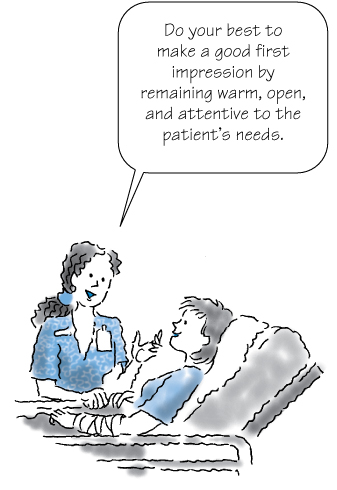
During the orientation phase, the patient will be forming a first impression of your meeting. They will be watching you closely and forming an opinion about your interest in their health care. By presenting a warm, caring manner, you’ll make this first impression, one that helps build a good nurse–patient relationship.
Trust building is a very important part of the therapeutic relationship you develop with the patient. If the patient doesn’t trust you, they won’t be open and answer your questions. Take time to sit down with them. Close the curtain so that they feel they have your undivided attention. Sit down in a chair so they do not feel that you’re in a hurry to leave. Also, act with integrity so that the patient can develop confidence in you and your abilities.
Patients are becoming increasingly knowledgeable about their bodies. They have access to a wealth of information today via the Internet, newspapers, and magazines. As patients learn more about how to stay healthy, they’re taking a more active role in their health care. You must recognize this role and respect it. Patients’ growing involvement in their own health care is helping to change the approach of many health care professionals from the authoritarian “Do as I say” attitude to the more cooperative “Here’s why I recommend this” approach.
As you begin to develop the therapeutic relationship with your patient, you develop a contract with them that’s built on trust and your mutual desire to see that he receives the treatment they need.
The working phase is a team-building phase that includes you, the patient, and the entire health care team. During this phase, you encourage the patient and help them to understand their condition and how to set goals. Using therapeutic communication, you encourage the patient to accomplish his goals.
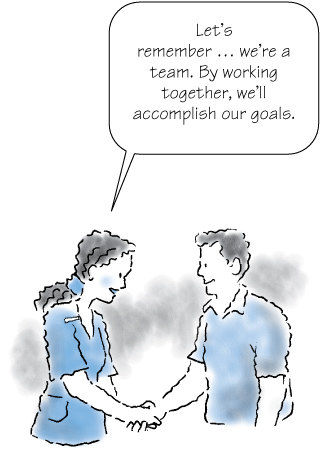
This phase is a give-and-take phase because you and the patient have specific roles to play and certain expectations of what will happen during the relationship. You, as the nurse, expect the patient to be willing to participate in their health care by providing accurate information, asking questions about treatments, and participating in treatment procedures as appropriate. The patient, on the other hand, expects that their health care needs will be met by you and the other members of the health care team. They expect you, as the health care advocate, to keep them informed and provide them with the correct treatments and procedures.
As you near the termination phase, you must remind the patient that the termination of the relationship is near. You can do so simply by saying good-bye at the end of your shift. However, termination can be more complex and include discharge planning. At the same time, you may also be paving the way for more relationships to develop with the patient’s health care team as you make necessary referrals for home care nurse visits and rehabilitation.
By making the termination phase an easy one, you achieve a smooth transition for the patient to other health care team members.
Using interpersonal skills in a healing way to help the patient is called therapeutic use of self. Three important techniques enhance therapeutic use of self:
 Exhibiting empathy
Exhibiting empathy Demonstrating acceptance
Demonstrating acceptance Giving recognition.
Giving recognition.| Memory Jogger |
When it comes to therapeutic interpersonal patient communication skills, lend an EAR! Make sure you show:
|
To show empathy, use phrases that address the patient’s feelings, such as “That must have upset you.”
To show acceptance, use neutral statements, such as “I hear what you’re saying” and “I see.” Nonverbal behaviors, such as nodding or making momentary eye contact, also provide encouragement without indicating agreement or disagreement.
To give recognition, listen actively to what the patient says, occasionally providing verbal or nonverbal acknowledgment to encourage him to continue speaking.
Various factors contribute to the communication process and directly affect a person’s ability to send and receive messages. In some cases, a patient’s special needs can be a deterrent to effective communication. However, these needs shouldn’t be an excuse for failing to find alternative ways to promote communication. As a nurse, you need to understand which factors influence communication so that you can clear away any barriers.
This diagram shows the components of nurse–patient communication. Note the factors that affect communication, such as orientation, preconceptions, and language. Your sensitivity to these factors makes the difference between effective and ineffective communication.


Communication barriers such as speaking another language and being hearing or speaking impaired are obvious communication barriers but aren’t insurmountable. What about the not-so-obvious barriers, such as dealing with a young child, an elderly patient, or an unconscious patient?
When dealing with a young patient, it’s essential to keep in mind the child’s developmental level. And in the case of a very young child, such as an infant, you need to communicate with the infant’s parents. Always use a caring and compassionate tone with the parents because, more than likely, they’re anxious about having their infant hospitalized.
Remember that children commonly regress to an earlier stage of development when they’re ill. Role playing is one way to communicate with children to find out how they’re feeling.
When possible, it’s ideal to prepare the child for admission to the hospital. The timing of the preparation and the amount of teaching given depend on the child’s age, developmental level, and personality, and the length of the procedure or treatment.
Young children may only need a few hours of preparation, whereas older children may benefit from several days of preparation. The use of developmentally appropriate activities will also help the child cope with the stress of hospitalization.

To reduce the fear that accompanies hospitalization, you can help the child and family cope by:
Explaining procedures
Answering questions openly and honestly
Minimizing separation from the parents
Structuring the environment to allow the child to maintain as much control as possible.
Always address an older patient as Miss, Mrs., or Mr., followed by the surname. Experts also recommend the use of touch. For example, shake the patient’s hand when you first meet them and say hello; then hold it briefly to convey concern. Use body language, touch, and eye contact to encourage participation. Be patient, relaxed, and unhurried. Suggest mentioning something here about sensory deficits in the elderly (e.g., visual and hearing deficits) and on incorporating devices such as eyeglasses and/or hearing aids.
Talk to the patient, not at them. Tell the patient how long the process will take. If language poses a problem, enlist the aid of an interpreter, family members, or a friend, as appropriate. Early in the interview, try to evaluate the patient’s ability to communicate and their reliability as a historian. If you have doubts, before the interview proceeds further, ask whether a family member or friend can be present.

Don’t be surprised if an older patient requests that someone assist them; they, too, may have concerns about getting through the interview on their own. Having another person present gives you a chance to observe the patient’s interaction with this person and provides more data for the history. However, the presence of another person may prevent the patient from speaking freely, so plan a talk privately at some time during your assessment.
Provide carefully structured questions to elicit significant information. Keep your questions concise, rephrase those the patient doesn’t understand, and use such nonverbal techniques as facial expressions, pointing, and touching to enhance your meaning.
Use terms appropriate to the patient’s level of understanding; avoid using jargon and complex medical terms. Offer explanations in lay terms, and then use the related medical terms, if appropriate, so the patient can become familiar with them.
To foster your older patient’s cooperation, take a little extra time to help them see the relevance of your questions. You may need to repeat an explanation several times during the interview, but don’t repeat unnecessarily. Give the patient plenty of time to respond to your questions and directions.
Remain silent and allow the patient time to collect their thoughts and ideas before responding. Patience is the key to communicating with an older adult who responds slowly to your questions. Even so, don’t confuse patience with patronizing behavior. The patient will easily perceive patronization and may interpret it as your lack of genuine concern.
When caring for an unconscious patient, don’t assume that you don’t need to try to communicate with them. Never assume that they can’t hear you. Introduce yourself as you would to a conscious patient. Always explain every procedure you’re doing. Don’t talk about the patient with other people in the room as if the patient weren’t present. Always treat the unconscious patient with kindness, consideration, and respect as you would a patient who’s conscious.
Patients are cared for by many people who work different shifts, and these various caregivers may speak with one another infrequently. The medical record is the main source of information and communication among nurses, doctors, physical therapists, social workers, and other caregivers. Today, nurses are commonly considered managers of care as well as practitioners, and nurses usually document the most information. Everyone’s notes are important, however, because together they represent a complete picture of the patient’s care.

As health care facilities continue to streamline and redesign care delivery systems, tasks that were historically performed by nurses are now being assigned to multiskilled workers such as nursing assistants. To deliver highly specialized care, each caregiver must provide accurate, thorough information and be able to interpret what others have written about a patient. Then each can use this information to plan future patient care. Commonly, decisions, actions, and revisions related to the patient’s care are based on documentation from various team members. A well-prepared medical record shows the high degree of collaboration among the entire health care team.
References
Berman, A., & Snyder, S. (2012). Kozier & Erb’s fundamental of nursing: Concepts, process, and practice (9th ed.). Upper Saddle River, NJ: Pearson.
Institute for Safe Medication Practice. (2013). Unresolved disrespectful behavior in healthcare practitioners speak up (again)—Part 1. Retrieved from http://www.ismp.org/Newsletters/acutecare/showarticle.asp?id=60
![]()
- When developing a therapeutic nurse–patient relationship, during what phase do you review the patient’s surgical history?
- What’s a good way to communicate with a very young child?
- What type of behavior provides encouragement during communication without indicating agreement or disagreement?
- What’s the main source of information and communication among nurses, doctors, physical therapists, social workers, and other caregivers?
 If you answered all four questions correctly, fantastic! You’re a communication connoisseur.
If you answered all four questions correctly, fantastic! You’re a communication connoisseur. If you answered three questions correctly, super! You’ve got a handle on handling communication strategies.
If you answered three questions correctly, super! You’ve got a handle on handling communication strategies. If you answered fewer than three questions correctly, no worries! Reflect on the chapter and try again.
If you answered fewer than three questions correctly, no worries! Reflect on the chapter and try again.Outline
